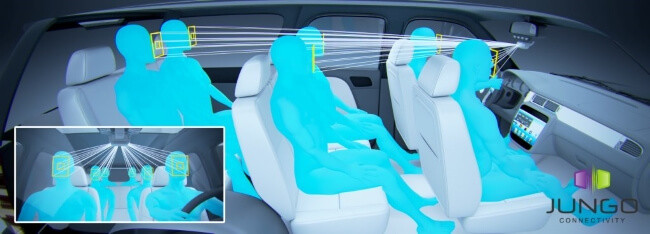Driving to be Safer with In-Car Monitoring
20-02-2020 | By Rob Coppinger
In-car LIDAR and artificial intelligence (AI) to detect driver gestures and drowsiness are being developed by Cisco Systems spinout Jungo Connectivity using Analog Devices’ technology.
Drivers will be able to access in-car services just with hand gestures and will be warned if they are becoming drowsy or are distracted by computer vision algorithms, AI and a light detection and ranging system (LIDAR). Analog Devices Inc (ADI) and Jungo Connectivity are working together on the in-cabin monitoring technology. The two companies are combining ADI’s 3D Time-of-Flight (3D ToF) technology with Jungo’s CoDriver software. The interior of the car is captured by the 3D ToF with its scannerless LIDAR which uses the high-power nanosecond optical pulses.
The pulses that capture the interior allow head and body position to be observed as well as the direction of eye gaze. It is scannerless because the LIDAR does not scan the scene, instead the environment is captured digitally with a single nanosecond pulse of light. CoDriver was designed to provide visual information about in-cabin behaviours and activities, leveraging computer vision and machine and deep learning software. CoDriver also supports functions such as counting occupants, detection of seat belt wearing or detection or observing of critical medical conditions.
“Jungo’s CoDriver monitoring algorithms are used by original equipment manufacturers (OEMs) to keep their drivers and passengers safe and develop innovative use cases that understand an occupant’s state while in the vehicle,” said Jungo chief executive officer, Ophir Herbst. “We are delighted to collaborate with Analog Devices to make vehicles smarter.” Jungo Connectivity was founded in 2013 as an automotive software divestiture from Cisco Systems, focusing on in-cabin driver monitoring solution.

CoDriver for Full Cabin Detection
Credit: Jungo
A Depth of Knowledge
The 3D ToF system is a self-contained depth detection system that outputs depth-per-pixel data and it does not need a back-end application processor to process the output data from the ToF sensor.
The ToF system uses a 640 x 480 pixel sensor which ADI says provides four times more resolution than many other ToF sensors on the market. This greater resolution enables users to detect smaller and thinner objects that could be invisible to other ToF sensors. Without the need for back-end processing, the processor can work on more processing-intensive applications.
Within the cabin, the greater resolution allows for a facial recognition capability that identifies individuals and could allow them to be given access to infotainment or personalised services or ridesharing payments. ADI offers products and solutions to improve the capabilities of 3D ToF systems, including processing, laser drivers and power management, development boards and software and firmware for the quick implementation of 3D ToF solutions. In addition, ADI also offers modules from its design services partners.
“The collaboration between ADI and Jungo opens the door to new and innovative augmented reality applications beyond today’s gesture control,” said Analog Devices’ Automotive Connectivity and Sensing product line director, Vlad Bulavsky. “We believe our work together can bring cabin sensing with ToF-based driver- and occupant monitoring to the next level and improve vehicle safety.”
